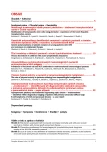Genetic polymorphisms of platelet receptors in young patients with AIM and resistance to antiplatelet therapy
Authors:
J. Úlehlová 1; L. Slavík 1; J. Kučerová 1; V. Krčová 1; J. Václavík 2; K. Indrák 1
Authors‘ workplace:
Hemato-onkologická klinika LF UP a FN Olomouc, I. interní klinika FN Olomouc
1
Published in:
Transfuze Hematol. dnes,18, 2012, No. 1, p. 14-18.
Category:
Comprehensive Reports, Original Papers, Case Reports
Overview
The studied group comprises 80 young patients with AIM on dual antiplatelet therapy with acetylsalicylic acid (ASA) and thienopyridines. Antiplatelet therapy was monitored by platelet-rich plasma light transmittance aggregometry using the APACT 4004 analyser (Helena Laboratories, Austria) and by whole blood impedance aggregometry using the Multiplate analyser (Dynabyte, Germany). Platelet aggregation was detected after stimulation with arachidonic acid for the detection of aspirin resistance and with ADP and prostaglandin E1 for the detection of thienopyridine resistance. To determine the frequencies of P2Y12 (i-744T>C; rs2046934), P2Y12 (34C>T; rs6785930) and COX-1 (-842A>G; rs10306114) polymorphisms, DNA of patients with AIM was tested by RT-PCR and melting curve analysis using the LightCycler 480 analyser (Roche Diagnostics, Germany).The cut-offs for patients with effective ASA therapy are 25% of aggregated platelets and 220 AUC/min respectively if LTA or MEA is used. The cut-offs for effective thienopyridine therapy are 45% of aggregated platelets or 298 AUC/min, respectively.The aim of our work was to use the two aforementioned functional laboratory methods to assess both aspirin and thienopyridine resistance and to determine the contribution of platelet receptor genetic polymorphisms to resistance to antiplatelet therapy in AIM.
Key words:
platelet gene polymorphisms, resistance to antiplatelet therapy
Sources
1. Cuisset T, Frere C, Quilici J, et al. Aspirin noncompliance is the major cause of „aspirin resistance“ in patients undergoing coronary stenting. Am Heart J 2009; 157 (5): 889-893.
2. Gurbel PA, Tandry US. Clopidogrel resistance? Thrombosis Research 2007; 120 : 311–321.
3. Ševčíková H. Rezistence na protidestičkovou terapii. Interv Akut Kardiol 2006; 5 : 256–258.
4. Cattaneo M, Lecchi A, Zighetti ML, et al. Platelet aggregation studies: autologous platelet poor plasma inhibits platelet aggregation when added to platelet rich plasma to normalize platelet count. Haematologica 2007; 92 : 694–697.
5. Cattaneo M. Resistance to platelet drugs: molecular mechanisms and laboratory detection. J Thromb Heamost 2007; 5(Suppl. 1): 230–237.
6. Mueller T, Dieplinger B, Poelz W, et al. Utility of whole blood impedance aggregometry for the assessment of clopidogrel action using the novel Multiplate analyzer - comparison with two flow cytometric methods. Thromb Res 2007; 121 : 249–258.
7. Seyfert UT, Haubelt H, Vogt A, et al. Variables influencing Multiplate(TM) whole blood impedance platelet aggregometry and turbidimetric platelet aggregation in healthy individuals. Platelets 2007; 18 : 199–206.
8. Blais N, Pharad Ch, Lordkipanidze M, et al. Response to aspirin in heathy individuals. Cross-comparison of light transmission aggregometry, VerifyNow system, platelet count drop, thromboelastography (TEG) and urinary 11-dehydrothromboxane B2. Thromb Haemost 2009; 102 : 404–411.
9. Kvasnička J, Hájková J, Bobčíková P, Křížová P, Dušková D, Poletínová Š, Kieferová V. Polymorfizmy krevních destiček a možnosti monitorace účinku protidestičkové léčby. Interv Akut Kardiol 2008; 7(6): 215–218.
10. Lepäntalo A, Mikkelsson J, Reséndiz JC, et al. Polymorphisms of COX-1 and GPVI associate with the antiplatelet effect of aspirin in coronary artery disease patients. Thromb Haemost 2006; 95(2): 253–259.
11. Linnemann B, Schwonberg J, Mani H, et al. Standardization of light transmittance aggregometry for monitoring antiplatelet therapy: an adjustment for platelet count is not necessary. J Thromb Haemost 2008; 6 : 677–683.
Labels
Haematology Internal medicine Clinical oncologyArticle was published in
Transfusion and Haematology Today

2012 Issue 1
Most read in this issue
- Asymptomatic pituitary macroadenoma oppressing optic chiasm – ‘incidentaloma‘ – identified within diagnostical staging of patient with primary extranodal diffuse large B-cell lymphoma of orbit and paranasal sinuses – a case report
- The role of physical activity in patients suffering from haematological malignancies
- Prevalence of red blood cell and HLA antibodies in multi-transfused haematological patients
- Mobilization of hematopoetic stem cells using plerixafor - experience of the Czech Republic transplantation centers
